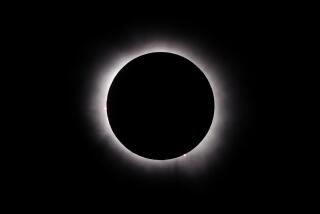2 major solar flares Friday -- the second twice as intense as the first
The sun shot out a pair of gigantic solar flares early Friday -- the second one even bigger than the first, a NOAA expert tells the Los Angeles Times.
An X1-class solar flare occurred at about 1 a.m. PDT, followed by an even larger one about eight hours later.
“This one was an X2, twice as intense as the X1 that just occurred,” said Bill Murtagh, program coordinator with the National Oceanic and Atmospheric Administration, in an interview Friday morning.
PHOTOS: Stunning views of the sun
News of the latest activity came as NASA released a spectacular video and image, see above, of a solar eruption in September, what the space agency termed a “canyon of fire.”
The video shows a 200,000-mile-long filament leaping from the atmosphere of the sun and creating a rippling, glowing canyon, which “traces the channel where magnetic fields held the filament aloft before the explosion,” NASA says.
So what’s with all the activity? Our home star is hitting solar maximum in its 11-year cycle activity, and scientists had predicted it would be meh -- a wimpier maximum than in cycles past.
Now we have a canyon of fire and X-class solar flares. (X is the largest class of flare, as measured in X-ray wavelengths.)
“This is a little bit of a change this week, we’re seeing a quite active sun,” Murtagh said. “Three different sunspot clusters. … We were just down in the operations center looking at this. We can see this complex little magnetic structure on the sun that’s going to produce these kind of flares.”
The latest activity disrupted high-frequency radio communications, which Murtagh said is a given when there’s an X-class flare. But these flares, and the material they ejected from the sun, were not pointed at Earth. When such coronal mass ejections head toward Earth, that’s a bigger deal.
PHOTOS: Past ISS crews and images from space
Such a geomagnetic storm could conjure the Northern Lights, as well as “affect power grids, cause airlines to reroute flights from polar regions,” Murtagh said.
The sunspot group that has been active Friday is rotating nearer the center of the sun, he noted. If the flares keep up, there could be more serious effects in store for Earth in the next three or four days.
Murtagh said that indeed this is the “lowest solar maximum since back in the 1900-1910 time frame.” But that doesn’t mean that X-class flares and their attendant problems will not occur.
“These things are going to pop up, just less frequently,” he said. “You can’t get complacent.”
Like solar flares and awesome space stories? Follow me @AmyTheHub







